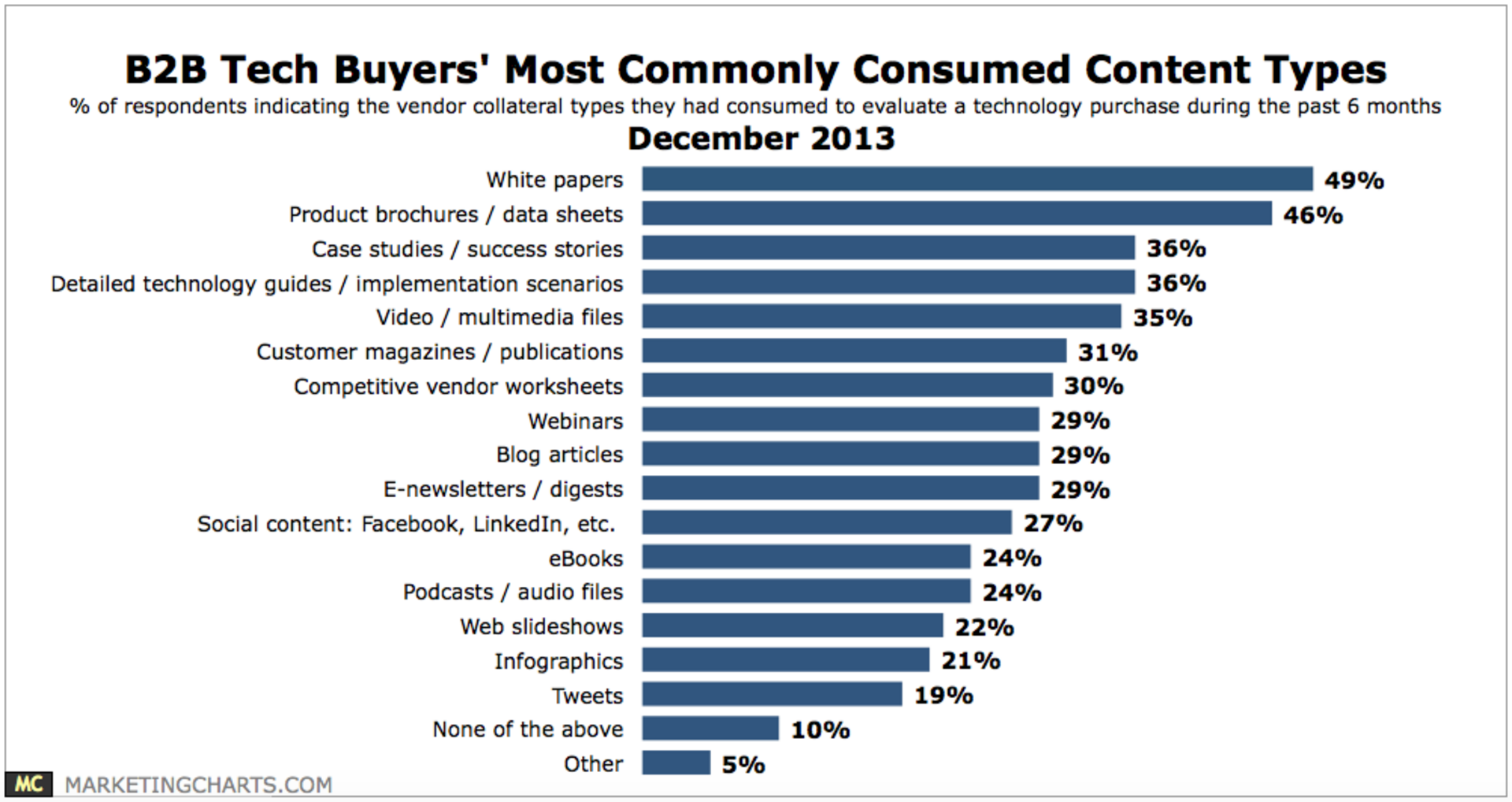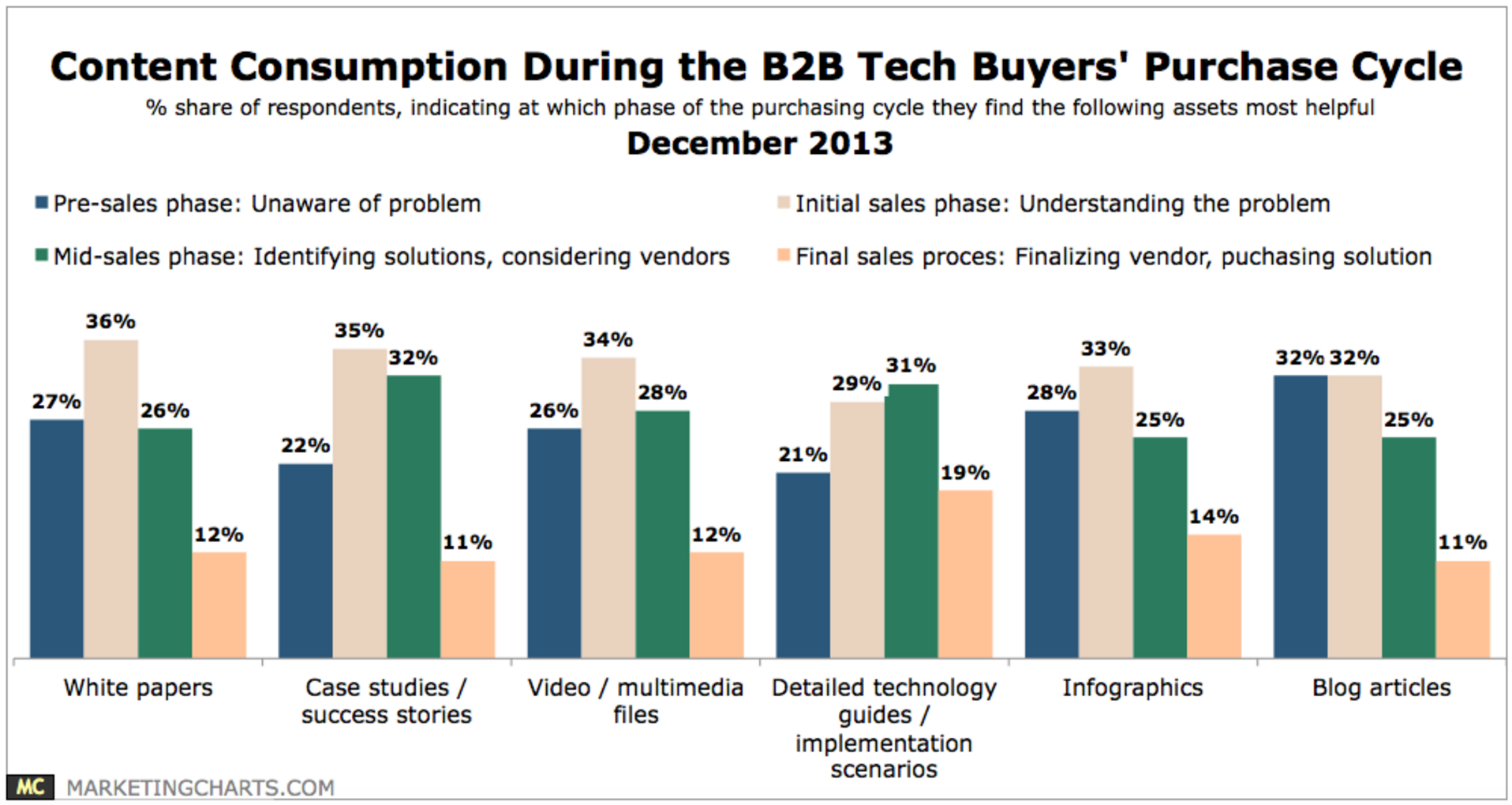Mapping Your Content to Your Sales Cycle
Previously on our blog, we discussed the five basics of content marketing. The first of these five basics of content marketing is understanding your audience, which we achieve by constructing personas. Once you know who your intended audience is, you can tailor your content to help encourage users to progress through each step of their individual buyer's journey. The example we used to illustrate this point was a piece of software. The content you create will differ depending on if you’re selling a single-use license or an enterprise-level SaaS solution -- and if you’re speaking to an end-user or a CTO, respectively.
The Most commonly consumed content types
Eccolo Media surveyed over 500 B2B technology buyers who were responsible for influencing the purchase of technology solutions in the six months before the survey to find the most commonly consumed content types:  They found that white papers were the highest consumed with 49% of respondents reported to have used them to evaluate a technology purchase. Product brochures and data sheets (46%) were a close second, with case studies/success stories (36%), detailed technology guides/implementation scenarios (36%), and video/multimedia files (35%) following. One of the more curious findings is that fewer respondents reported that they had consumed blog posts (29%), email newsletters (29%), social content (27%), infographics (21%), or tweets (19%) -- all of the more common content marketing efforts. However, there also appeared to be a greater diversification in the types of content consumed by buyers. Eccolo Media noted that the number of content types had expanded to 16 from as few as five in years past, indicating that buyers were more willing to spread their attention to other sources.
They found that white papers were the highest consumed with 49% of respondents reported to have used them to evaluate a technology purchase. Product brochures and data sheets (46%) were a close second, with case studies/success stories (36%), detailed technology guides/implementation scenarios (36%), and video/multimedia files (35%) following. One of the more curious findings is that fewer respondents reported that they had consumed blog posts (29%), email newsletters (29%), social content (27%), infographics (21%), or tweets (19%) -- all of the more common content marketing efforts. However, there also appeared to be a greater diversification in the types of content consumed by buyers. Eccolo Media noted that the number of content types had expanded to 16 from as few as five in years past, indicating that buyers were more willing to spread their attention to other sources.
what content and when?
Pardot’s report, “The State of Demand Generation”, found that three-quarters of B2B buyers preferred to consume different types of content at the various stages of their buying process. That makes the next research from Eccolo Media even more compelling -- they analyzed six different content types and how useful the survey’s respondents found them during each stage of their purchase cycle:  Comparing the consumption of white papers, case studies/success stories, video/multimedia files, detailed tech guides/implementation scenarios, infographics, and blog articles across the purchase cycle led to the following conclusions:
Comparing the consumption of white papers, case studies/success stories, video/multimedia files, detailed tech guides/implementation scenarios, infographics, and blog articles across the purchase cycle led to the following conclusions:
- During the pre-sales phase (“unaware of problem”), 32% of buyers found blog articles to be at their most helpful (blog articles were found to be equally as influential during the initial sales phase);
- During the initial sales phase, white papers, case studies, videos, and infographics were at their most influential point;
- At the mid-sales phase, detailed technology guides (31%) were at their most influential, while case studies (32%) were also important; and
- None of the collateral types are clearly the most influential during the final sales process, although detailed technology guides/implementation scenarios (19%) are naturally of more interest during this stage.
And for who?
But perhaps most interestingly, the report also broke down the preferences into six different personas: small business influencers and decision-makers, mid-market influencers and decision-makers, and enterprise influences and decision-makers. Marketing Charts published the following highlights of when the different content types were considered to be the most influential by each persona during the stages of the purchase cycle:
Pre-Sales
- Small business influencers consider detailed technology guides and multimedia assets to be at their most influential during this phase, while small business-decision makers see blog articles as carrying their greatest weight;
- Mid-market influencers, mid-market decision-makers, and enterprise influencers don’t see any of the content types as being at their most helpful point during the pre-sales phase; and
- Enterprise decision-makers find blog articles and infographics to be offering their greatest influence during this stage.
Initial Sales
- Small business influencers consider infographics, case studies, and white papers to be at their most helpful during this phase, while small business-decision makers agree in each respect except for the case studies;
- Mid-market influencers tend to see most content types – blog articles, infographics, video, case studies, and white papers – as being most helpful during this stage;
- Mid-market decision-makers find that blog articles, infographics, videos, and white papers are more influential at this stage than at any other;
- Enterprise influencers consider blog articles, infographics, videos, case studies, and white papers to be most influential at this stage; and
- Enterprise decision-makers perceive infographics, videos, and white papers to be at their most helpful during this stage.
Mid-Sales
- For small business influencers, this is the phase when blog articles are their most helpful, while small business decision-makers see videos and case studies as carrying their biggest influence during this phase;
- Mid-market influencers tend to see detailed tech guides as being their most helpful during this stage, while decision-makers agree and add case studies as having their greatest influence at this point;
- Enterprise influencers and decision-makers each consider detailed technology guides to be most helpful at this point, with decision-makers also believing that case studies are most important at this stage.
Final Sales Process
- None of the personas considered any of the content types to be most helpful during this stage, as buyers appear to see each type of collateral as being most important during earlier phases of the sales cycle.
Conclusion
As a content marketer, delivering the types of content that your audience finds the most influential to consume helps to meet their needs. By relying on the personas you created previously, as well as tailoring the types of content you deliver, and when you can maximize your efforts and help them progress through to the next phase of their buying cycle -- and, ultimately, to convert them into customers.







